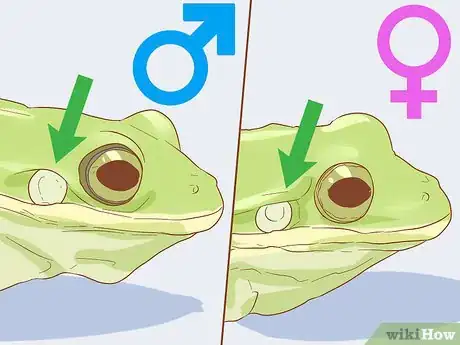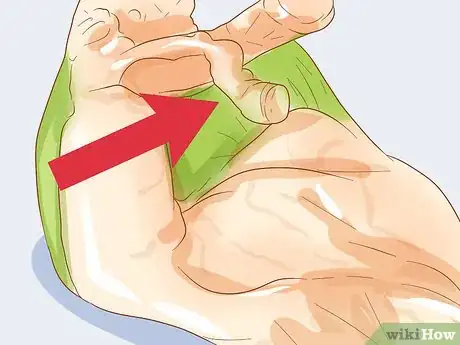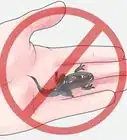wikiHow is a “wiki,” similar to Wikipedia, which means that many of our articles are co-written by multiple authors. To create this article, 39 people, some anonymous, worked to edit and improve it over time.
wikiHow marks an article as reader-approved once it receives enough positive feedback. This article received 35 testimonials and 87% of readers who voted found it helpful, earning it our reader-approved status.
This article has been viewed 427,872 times.
Learn more...
Recently buy a pet frog and unsure what to name it? Don't worry — while all frog species are different, there are many ways to tell male and females apart that are true for the majority of frogs. Learn what to look for in your tree frog's appearance and behavior to tell its sex in seconds!
Steps
Appearance Clues
-
1Measure its size. For most species of frog, males are noticeably smaller than females. Tree frogs generally range from 1-5.5 inches (3-14 centimeters) depending on the precise species.[1] . Females are typically about half an inch longer and slightly heavier than males of the same species.
- The reason for this has to do with the way frogs mate. Males have to climb all the way onto females' backs to mate, so the female has to be larger so that the male's weight doesn't hurt her.[2]
-
2Look for the presence of a vocal sac. Since male frogs do the vast majority of the croaking (more on this below), they usually have specially-constructed throats designed for this purpose. Most male frogs (including tree frogs) have something called a "vocal sac" on their throats. This sac can inflate full of air like a balloon when the frog croaks. When the frog isn't croaking, the deflated sac may make the skin on the throat seem more thin and baggy than on female frogs.[3]
- In addition, the skin of the vocal sac will often be a different color than the rest of the underside. Yellowish or black shades are common.
Advertisement -
3Check the size of the ears. Instead of having ears that stick out from their heads like humans, frogs' ears are flat discs of skin on the sides of their heads behind their eyes. These discs are sometimes (but not always) a different color than the skin around them. Male frogs tend to have ears that are larger than their eyes. By contrast, female frogs tend to have ears that are about the same size as their eyes (or slightly smaller.[4]
-
4Look for pads next to the thumbs. Male frogs (including tree frogs) often have special features on their hands and arms that make it easier to cling to female frogs' backs for mating purposes. For example, male frogs sometimes have a patch of rough, raised flesh on each of their thumbs. If the thumb seems to be larger and thicker than the other digits, especially at its base, the frog is probably a male.
- This feature may be difficult to see except in the breeding season, when it enlarges in time for mating.
-
5Look for less-common differences in appearance. There are many other external features that can vary between male and female frogs. A few of these are listed below.[5] These vary between species: some frogs may have them and others may not. Some are also time-dependant — for example, the hand hooks described below often develop only during the mating season.
- Some male frogs will have thicker arms with more noticeable muscle definition.
- Some male frogs will develop hook-shaped adornments on their hands used for gripping onto females for mating purposes.
- In some species, male frogs will have rougher skin (sometimes with small spines) while female frogs will have smooth skin.
Behavior Clues
-
1Listen for croaking at night. Male frogs are the ones who seem to croak at night without stopping. They do this to attract mates around breeding spots — female frogs use the calls of the males to determine which ones are healthiest and most attractive. Females, on the other hand, don't usually make much noise.[6] .
- This isn't to say that female frogs don't make any noise. Female frogs may occasionally croak or call out in response to something else. For instance, female frogs will "scream" when grabbed by a predator. However, they won't croak constantly at night like most male frogs.
-
2Look for "humping" behavior. There's no nice way to say this — male frogs will occasionally "hump" things. In other words, they will climb onto something, grasp it with their forelegs, and press the underside of their bodies against it tight. They often won't use an obvious "thrusting" motion like a male dog, but their intention should be obvious.
- This isn't just restricted to female frogs (although this is often the case). Male frogs may "hump" or hug objects like plants or rocks. They may even hump other male frogs. Female frogs, however, will not hump.
-
3Learn which behaviors aren't indicative of sex. Some behaviors may seem like things that only male or female frogs would do, but in fact are not. A few of these are listed below:[7]
- Both male and female frogs will defend themselves or attempt to run if threatened.
- Both male and female frogs shed skin.
- Both male and female frogs will attempt to camouflage themselves against similarly-colored things.
- Male and female frogs of the same species have the same diet.
-
4When all else fails, ask an experienced breeder or a veterinarian. It's not always easy to tell male and female tree frogs apart, especially if you are dealing with a very small species or a species without obvious male/female appearance variations. In these cases, you may want to consult an expert. Biologists, amphibian experts, veterinarians, and similar professionals can all be valuable resources.
Community Q&A
-
QuestionWhat do I feed my baby frogs?
 Community AnswerYou can feed them algae wafers until they are just getting their legs. Then, they can eat fruit flies and the like.
Community AnswerYou can feed them algae wafers until they are just getting their legs. Then, they can eat fruit flies and the like. -
QuestionMy frog is getting darker. What does this mean?
 Community AnswerIt could be from stress or something abnormal in their environment. Check to make sure that the tank/water isn't too warm. Also, make sure your frog is getting the proper nutrients from its food.
Community AnswerIt could be from stress or something abnormal in their environment. Check to make sure that the tank/water isn't too warm. Also, make sure your frog is getting the proper nutrients from its food. -
QuestionHow do I catch wild frogs?
 Community AnswerIf you live near a pond or creek, they are commonly found in the shallow end. During breeding season, there will be multiple tadpoles. Keep the tadpoles until they turn into frogs. The size of the tadpoles will vary the size of the frog, thus, small tadpoles will be small frogs, and large tadpoles will be large frogs.
Community AnswerIf you live near a pond or creek, they are commonly found in the shallow end. During breeding season, there will be multiple tadpoles. Keep the tadpoles until they turn into frogs. The size of the tadpoles will vary the size of the frog, thus, small tadpoles will be small frogs, and large tadpoles will be large frogs.
References
- ↑ http://a-z-animals.com/animals/tree-frog/
- ↑ http://australianmuseum.net.au/blogpost/science/how-can-you-tell-a-male-from-a-female-frog
- ↑ http://australianmuseum.net.au/blogpost/science/how-can-you-tell-a-male-from-a-female-frog
- ↑ http://www.choosingvoluntarysimplicity.com/how-to-tell-if-a-frog-is-male-or-female/
- ↑ http://australianmuseum.net.au/blogpost/science/how-can-you-tell-a-male-from-a-female-frog
- ↑ http://australianmuseum.net.au/blogpost/science/how-can-you-tell-a-male-from-a-female-frog
- ↑ http://animals.mom.me/differences-between-male-female-frog-5382.html
- ↑ http://animals.mom.me/differences-between-male-female-frog-5382.html
About This Article
To tell if your tree frog is male or female, measure its size, since females are typically half an inch larger than males. Next, check whether your frog has a vocal sack on its throat, which may look like baggy skin, because only males have vocal sacks. If you're still unsure, look out for specific behaviors that identify a male frog, such as croaking at night or humping objects. To learn what common behaviors are not unique to male or female frogs, read on!







































































